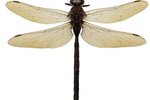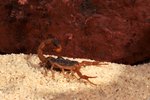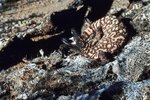
The Sahara Desert, an ecological zone of scorching heat, harsh winds and little water, covers much of northern Africa. Hundreds of animal species call the desert home, but scorpions are one of the most commonly associated with the arid region. These arachnids feature specialized adaptations that help them not only survive, but thrive in the world’s largest hot desert; more than 30 scorpion species inhabit the Sahara.
Flexible Diet
Desert scorpions are carnivores that typically eat insects or other invertebrates; however, they are opportunistic predators. Scorpions consume spiders, centipedes, earthworms, termites, ants, scarab beetles and even turn cannibalistic and prey upon other scorpions. One of the most prevalent scorpion species in the Sahara, the deathstalker scorpion (Leiurus quinquestriatus), commonly preys upon its own species.
Hydration
Scorpions rarely drink water; after all, a watering hole in the Sahara is a rare sight. Instead, they hydrate themselves via their prey. Scorpions absorb fluids through the flesh and organs of their prey. Nocturnal by nature, scorpions hunt at night, thereby escaping the desert sun’s intense, dehydrating heat.
Metabolism Regulation
One of the scorpion’s most distinct adaptations is its ability to control its metabolism. Food is often scarce in the Sahara. In these times of dwindling food sources, the scorpion will slow its metabolism to as little as one-third the normal rate. This allows them to use very little oxygen and survive on as few as one or two insects a year. The scorpion, however, has the unique ability to quickly reverse its hibernation and spring back to predatory action when food becomes available.
Burrowing and Hiding Behavior
Scorpions are burrowing animals. The Sahara’s loose sand and soil provides their necessary habitat. These arachnids take refuge in burrows during the day when temperatures soar to over 100 degrees. Scorpions also love to hide under rocks or small boulders, both as protection from the elements and as a means of concealment when hunting.
Exoskeleton
Scorpions, like all arthropods, have tough exoskeletons. Like sub-tropical scorpions, scorpions in the Sahara wear their exoskeletons like protective armor; it prevents them from being easily crushed. However, desert scorpions also use their tough, segmented exoskeletons as protection from the sun’s harsh rays and a sandstorm’s turbulent winds and debris, while its waxy nature minimizes water loss.
References
Photo Credits
-
Stockbyte/Stockbyte/Getty Images
Writer Bio
Christina Stephens is a writer from Portland, Ore. whose main areas of focus are pets and animals, travel and literature. A veterinary assistant, she taught English in South Korea and holds a BA in English with cum laude honors from Portland State University.




